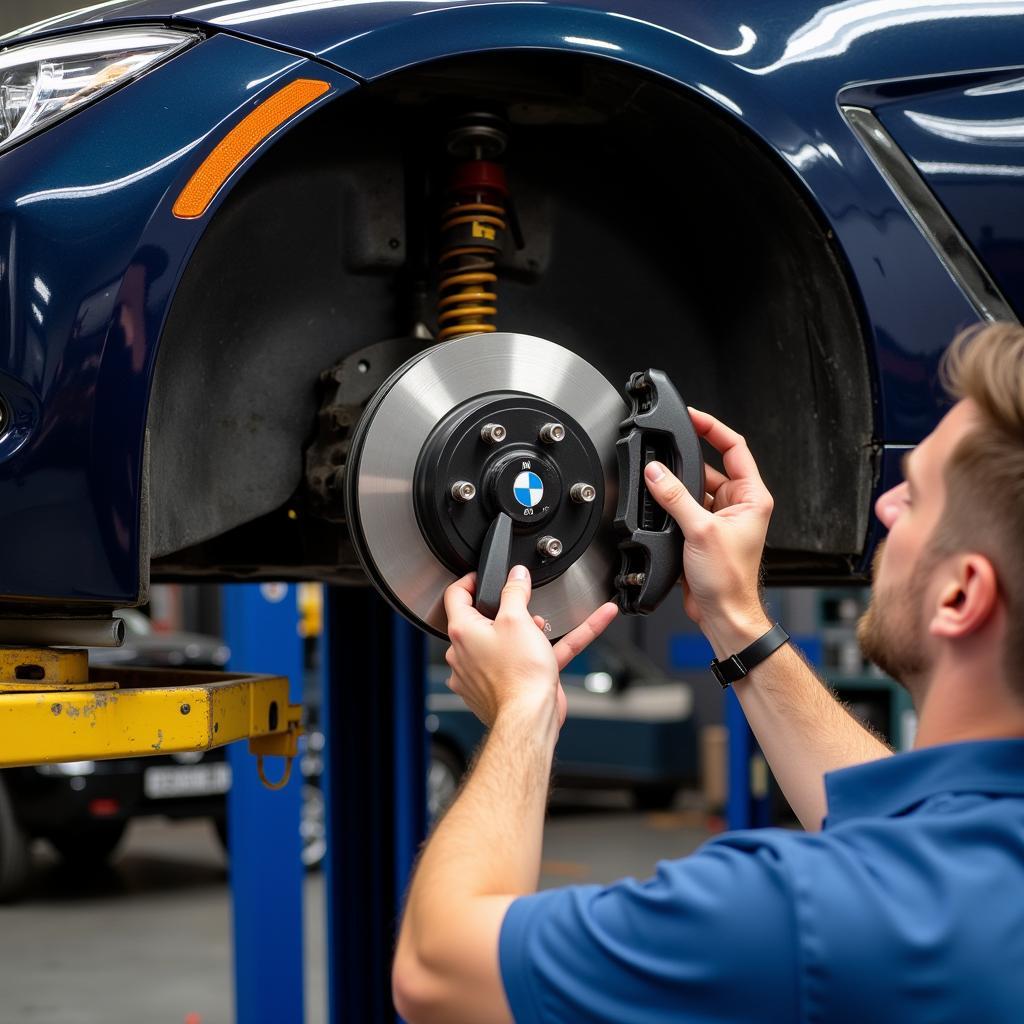Seeing a brake warning light illuminated on your BMW’s dashboard can be unsettling. However, it’s important to remember that this warning light doesn’t always signal a critical issue. It could indicate something as simple as worn brake pads or as complex as a malfunctioning ABS system. This comprehensive guide will walk you through the common causes of a BMW brake warning light and provide you with a step-by-step approach to diagnose and potentially resolve the issue.
Understanding Your BMW’s Brake Warning System
BMW vehicles are equipped with a sophisticated electronic braking system that continuously monitors various components. When the system detects an anomaly, it triggers the brake warning light on your dashboard. This light can manifest in several ways:
- Solid Red Light: This typically indicates a significant issue with your braking system, requiring immediate attention.
- Flashing Red Light: This usually signals a critical problem, often related to the brake fluid level or a malfunctioning ABS system.
- Yellow Light: This often points to an issue with the brake pad wear sensors or a general system malfunction that needs addressing.
Common Causes of a BMW Brake Warning Light
Before you delve into troubleshooting, it’s helpful to understand the common culprits behind a lit brake warning light:
- Worn Brake Pads: One of the most frequent reasons, brake pads have sensors that trigger the warning light when they wear down to a certain level.
- Low Brake Fluid: Brake fluid is crucial for transferring force from the brake pedal to the wheels. Low fluid levels can significantly impact braking performance.
- Faulty Brake Sensors: Sensors play a vital role in monitoring various brake components. A malfunctioning sensor can lead to a false warning light.
- ABS Module Issues: The Anti-lock Braking System (ABS) ensures optimal braking performance by preventing wheel lockup. Issues within this module can trigger the warning light.
- Parking Brake Engaged: A simple yet often overlooked reason is an inadvertently engaged parking brake.
How to Diagnose the Problem
Accurately diagnosing the problem is crucial for effective resolution. Here’s a systematic approach:
- Check the Parking Brake: Ensure the parking brake is fully disengaged.
- Inspect Brake Fluid Level: Locate the brake fluid reservoir (refer to your owner’s manual) and check the fluid level. If it’s below the minimum mark, add the recommended brake fluid type.
- Inspect Brake Pads: Visually inspect the brake pads through the wheel spokes. If they appear significantly worn down, it’s time for a replacement.
When to Consult a Professional
While some brake warning light issues can be resolved with basic checks, others require professional expertise. Consider consulting a qualified BMW technician if:
- The Warning Light Persists: If the light remains on after checking the brake fluid and parking brake, and you’re confident the brake pads aren’t worn, a deeper diagnosis is necessary.
- You’re Uncomfortable with DIY: Working with brakes involves safety risks. If you’re not confident in your mechanical skills, it’s best to leave it to the professionals.
- The Warning Light Flashes: A flashing brake warning light often signals a critical problem requiring immediate attention.
Resetting the Brake Warning Light
In most cases, simply addressing the root cause (like adding brake fluid or replacing worn pads) will automatically extinguish the brake warning light. However, certain issues might require a manual reset using a specialized diagnostic tool. This is typically done by a qualified technician.
Expert Insight: “Modern BMWs have intricate electronic systems. While DIY troubleshooting is encouraged for minor issues, it’s always recommended to consult a professional for complex brake system problems.” – Mark Stevenson, Senior BMW Technician
Tips to Prevent Future Brake Warning Lights
- Adhere to BMW’s Recommended Maintenance Schedule: Regular brake inspections are crucial for early detection of potential issues.
- Avoid Riding the Brakes: Continuously keeping your foot on the brake pedal can lead to premature wear and tear.
- Be Mindful of Unusual Noises: Squealing or grinding sounds during braking often indicate worn brake pads.
FAQs
Q: Can I drive my BMW with the brake warning light on?
A: It’s strongly advised against driving with an illuminated brake warning light. It indicates a potential issue with your braking system that could compromise your safety.
Q: How much does it cost to fix a BMW brake warning light issue?
A: The cost varies depending on the underlying problem. A simple brake fluid top-up might cost under $50, while a complete brake pad replacement could range from $200 to $500 or more, depending on the model and labor costs.
Q: Can I use any brake fluid in my BMW?
A: No, it’s crucial to use the brake fluid type specified in your BMW’s owner’s manual. Using the wrong fluid can damage your braking system.
Conclusion
Addressing a BMW brake warning light promptly is essential for ensuring your safety and the longevity of your vehicle. By following the diagnostic steps outlined in this guide, you can potentially pinpoint the issue. However, always prioritize safety and consult a qualified BMW technician for complex problems or if you’re unsure about any aspect of your car’s braking system. Remember, maintaining your BMW’s braking system is paramount for a safe and enjoyable driving experience.

